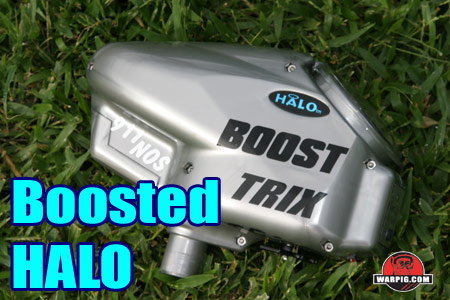  |
|
|
|
|
|
|
  |
|
|
|
|
|
|

Boost Custom Paintball
What
do you think?
|

Boosted HALO By Bill Mills - Oct 2005 David Cross, working under the name Boost Custom Paintball has been marketing assorted custom loader battery solutions, as well as building customized loaders for his customers. While each Boosted HALO may be different, depending on the customer’s specifications, the model reviewed is typical of what Cross produces. Central to the Boost modification is a boosted electrical system. A 1400 mAh Lithium Ion battery pack acts as the main power supply for the Boosted HALO. Lithium Ion batteries have been a staple in the world of camcorders for years. Their typical discharge curve provides a steady current with little drop off until the battery is completely drained. This provides full operational power for a longer period of time than most rechargeables that will provide less and less voltage over time as they discharge.
The lithium ion pack in the Boosted HALO replaces the six cell AA pack, and remains inside the loader. Rather than needing to remove it to recharge, a charging port is installed near the HALO’s feedneck. A lithium ion compatible battery charger can be attached to the port, between game days, and the HALO stays fresh and ready to go. The rechargeable battery pack is rated to provide 750 milliamp hours of power at 10.4 volts. According to Cross this is usually enough for five to six cases of paint – ample power for a typical day or recreational paintball, and even on par for 5-man tournament play.
Because the battery pack delivers 10.4 volts, rather than the 9 volts with normal alkaline batteries used in the HALO, it ends up driving the HALO’s motor with higher voltage for a faster speed. Behind the charging port is a small switch, the Boost switch. Because the lithium ion batteries maintain a steady voltage, and are cut off by their discharge circuit they don’t just get progressively weaker warning the user that it’s time for a recharge. They run, run and run some more, then simply don’t have the energy to run anymore. As an added player protection, the boost switch kicks in a second battery pack – a boost hot pack single use lithium battery. This 1300 mAh 12 volt battery not only backs up the rechargeable, but can be used on demand to drive the HALO at an even higher voltage for higher speed. A small guard adhered to the loader body provided added protection to both the charging port and the Boost switch. While this guard held up through use, it looked as though it might not be quite as durable as the components it was protecting, which were likely to handle a paintball hit without problem. When the Boost mode is enabled, the HALO has the ability to draw more power from the combined battery packs, either to give a performance boost, or to act as a reserve, to keep playing after the rechargeable battery is used. A small red light emitting diode (LED) sits low on the back on the HALO, indicating the Boost switch status. In the field the LED proved a little difficult to see in bright sunlight. Shading it with a hand was necessary to clearly see whether the loader was in its Boost mode or not. It was a simple matter, however to learn that with the switch forward, Boost was activated, and with the switch back it was not.
Extra switches and lights are fun, but with loaders, performance is the bottom line. To see what difference the Boost modifications made, the loader was tested on the WARPIG Ballistic Labs test stand with a Matrix LCD body.
To review the test data, click here. In practical testing, the loader performed as it should. The simple plug and play use of the charging port was a very convenient feature. Since the loader performed without problem there was no need to kick in the Boost switch on the field, but the knowledge that it was there in case of a problem with the rechargeable pack was reassuring. In addition to the Boost built to order
custom loaders, the Boost Hot packs, wiring harnesses, rechargeable lithium
ion batteries, and hopper bodies wired with charging ports are available
through Bradys Paintball.
|
| Copyright © 1992-2019
Corinthian Media Services. WARPIG's webmasters can be reached through our feedback form. All articles and images are copyrighted and may not be redistributed without the written permission of their original creators and Corinthian Media Services. The WARPIG paintball page is a collection of information and pointers to sources from around the internet and other locations. As such, Corinthian Media Services makes no claims to the trustworthiness or reliability of said information. The information contained in, and referenced by WARPIG, should not be used as a substitute for safety information from trained professionals in the paintball industry. |